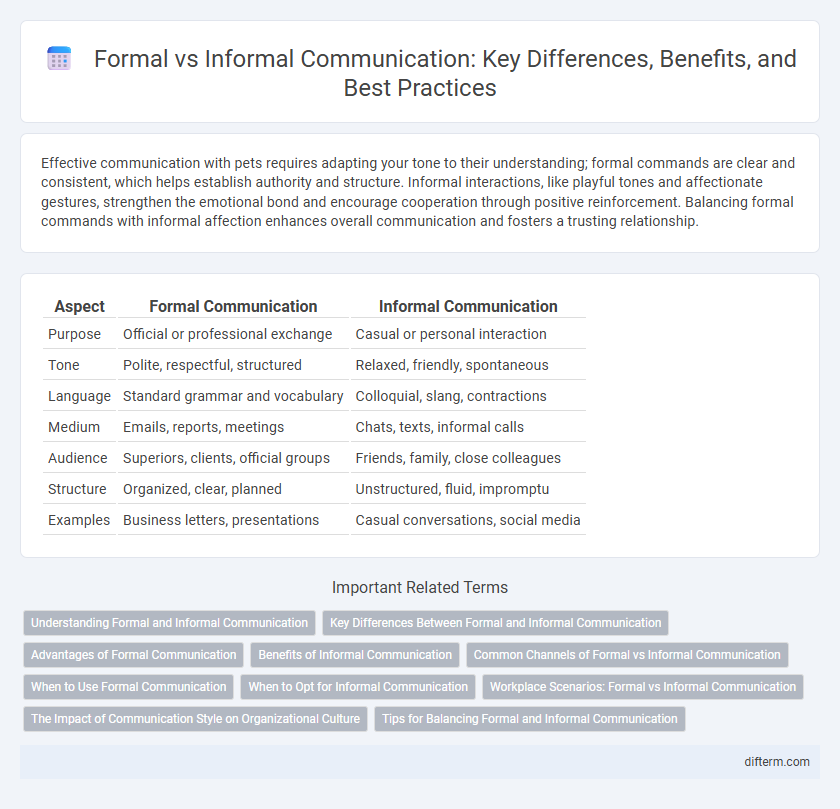Effective communication with pets requires adapting your tone to their understanding; formal commands are clear and consistent, which helps establish authority and structure. Informal interactions, like playful tones and affectionate gestures, strengthen the emotional bond and encourage cooperation through positive reinforcement. Balancing formal commands with informal affection enhances overall communication and fosters a trusting relationship.
Table of Comparison
| Aspect | Formal Communication | Informal Communication |
|---|---|---|
| Purpose | Official or professional exchange | Casual or personal interaction |
| Tone | Polite, respectful, structured | Relaxed, friendly, spontaneous |
| Language | Standard grammar and vocabulary | Colloquial, slang, contractions |
| Medium | Emails, reports, meetings | Chats, texts, informal calls |
| Audience | Superiors, clients, official groups | Friends, family, close colleagues |
| Structure | Organized, clear, planned | Unstructured, fluid, impromptu |
| Examples | Business letters, presentations | Casual conversations, social media |
Understanding Formal and Informal Communication
Formal communication involves structured exchanges using official channels, such as memos, reports, and formal meetings, ensuring clarity and professionalism in organizational contexts. Informal communication consists of spontaneous, casual interactions like conversations, emails, or social media messages, fostering quick information sharing and relationship building. Understanding the distinctions between formal and informal communication enhances effective message delivery and adapts communication style to audience and context.
Key Differences Between Formal and Informal Communication
Formal communication employs structured language, follows established protocols, and is often used in professional or official settings, ensuring clarity and authority. Informal communication uses casual language, spontaneity, and personal tone, typically seen in social or relaxed environments, promoting ease and interpersonal connections. Key differences include tone, purpose, medium, and level of professionalism, with formal communication prioritizing precision and informal emphasizing friendliness.
Advantages of Formal Communication
Formal communication ensures clarity and professionalism by following structured channels and established protocols, reducing misunderstandings in organizational settings. It enhances accountability through documented exchanges, facilitating efficient record-keeping and legal compliance. This communication style supports consistency in messaging, reinforcing organizational culture and authority.
Benefits of Informal Communication
Informal communication fosters quicker decision-making and enhances creativity by allowing spontaneous idea exchange among team members. It builds stronger interpersonal relationships, increasing trust and collaboration within the workplace. This type of communication reduces misunderstandings by promoting open, candid dialogues that improve overall organizational efficiency.
Common Channels of Formal vs Informal Communication
Formal communication commonly uses emails, official meetings, and memos to ensure clarity and record-keeping in professional environments. Informal communication often occurs through instant messaging apps, casual conversations, and social media platforms, fostering quick and spontaneous exchanges. Understanding these channels helps organizations maintain structured workflows while encouraging open dialogue among employees.
When to Use Formal Communication
Formal communication is essential in professional settings such as corporate meetings, official reports, and legal documentation where clarity, precision, and respect are paramount. It ensures that messages are conveyed with appropriate tone and structure, minimizing misunderstandings in hierarchical environments or cross-cultural interactions. This style is crucial when addressing superiors, clients, or external stakeholders to maintain professionalism and credibility.
When to Opt for Informal Communication
Informal communication is ideal in situations requiring quick decision-making, fostering creativity, or building personal relationships within teams. It enhances spontaneity and reduces hierarchical barriers, making it effective during brainstorming sessions or casual check-ins. Choosing informal communication supports a relaxed atmosphere where employees feel more open to sharing ideas and feedback.
Workplace Scenarios: Formal vs Informal Communication
Formal communication in the workplace involves structured exchanges such as official emails, reports, and meetings that ensure clarity, professionalism, and adherence to organizational protocols. Informal communication occurs through casual conversations, instant messaging, and social interactions, fostering team bonding and swift information flow. Balancing formal and informal communication enhances workplace efficiency by promoting clear directives while maintaining a collaborative environment.
The Impact of Communication Style on Organizational Culture
Communication style significantly influences organizational culture by shaping interpersonal dynamics and establishing workplace norms. Formal communication fosters clarity, professionalism, and consistency, which enhances accountability and aligns employees with corporate goals. Informal communication promotes openness, creativity, and trust, often accelerating problem-solving and strengthening team cohesion within organizations.
Tips for Balancing Formal and Informal Communication
Balancing formal and informal communication involves assessing the audience and context to choose the appropriate tone and language style. Use clear, professional language in formal settings while incorporating a friendly, conversational approach in informal interactions to build rapport and maintain clarity. Establish boundaries by recognizing when to switch between both styles to enhance understanding and foster positive relationships.
formal vs informal Infographic

 difterm.com
difterm.com